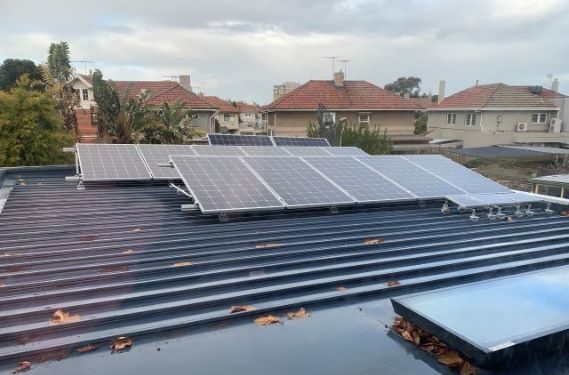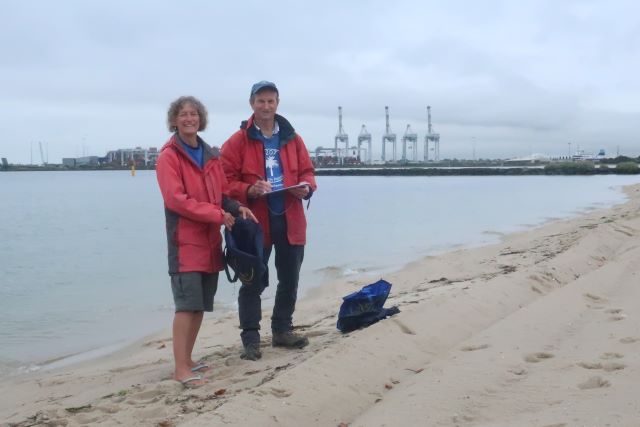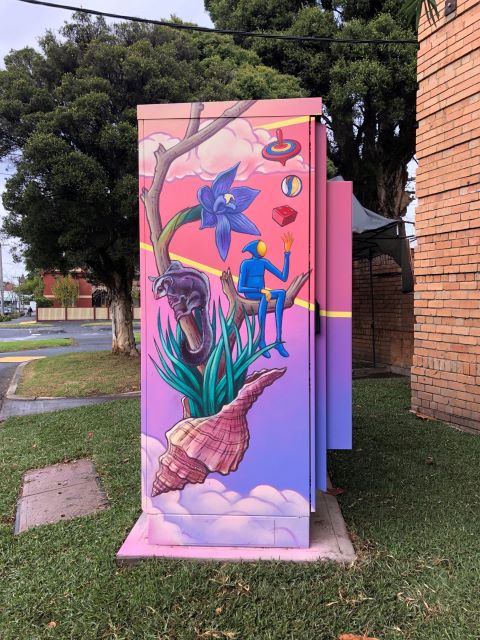
Retrofitting a bank house in Port Melbourne

Ramona and Ross Headifen are well known, and loved, in Port Melbourne. They are dedicated to highlighting the issue of micro-plastic pollution of the Bay, convene 3207 Beach Patrol and are committed members of the Port Melbourne Icebergers.
Winter solstice swim is coming up!
In 2019 they started acting on their vision to drastically reduce their carbon emissions at their house and their work. They began a renovation of the rear lounge kitchen area of their Port Melbourne Bank house. These historic 1930s houses are known for their distinctive architecture and solid construction. What they are not known for is their winter warmth and low energy bills.
During the renovation they
- Replaced all the windows with double glazed windows.
- Re-insulated the roof cavity, insulated all the new walls and underfloor areas.
- Laid the main floor laid with 20 mm thick recycled timber as wood has very high insulation properties.
- Installed ceiling fans in the living areas to avoid the used of air conditioning in summer.
- Changed the lighting to LED, with some in hallways and bathrooms on motion sensors so they would automatically turn off after a short time.
- Installed solar lights for three Internal rooms with no natural light or dark areas. These fill the rooms with light during the day and so there is no need to turn on any power lights.
- Installed a 5.7 kw (19 panels) solar system on the new roof over the lounge. This solar capacity surpasses all their summer energy requirements with excess exported to the grid. In winter there is still a net draw from the grid. Two solar monitoring systems were installed. Tigo optimisers on all panels were installed to allow each panel to operate independently. A Tigo monitoring system to monitor individual panels to check their performance and another system to monitor the overall production, house usage and net export to the grid.
- Replaced the gas cook top with an induction top that uses a fraction of the energy that a gas stove uses. It only heats the pot, not all the air around it.
- Replaced the gas oven with an all-electric dual oven with one smaller volume oven and a normal sized one. The small oven is used for cooking small-medium dishes or reheating food. It avoids the energy waste of using a larger volume oven.
- Installed a Catch Power device on the electric hot water system. This device looks at the solar inverter excess power output and the requirements of the hot water cylinder to match them up, minimising heating water when there is no solar input.
- Used recycled plastic planking for the new deck at the rear of the house. This is essentially maintenance free (no deck oiling) and the colour will not fade over time.
- Installed a 3000 litre rain water tank for their gardens and general outside item rinsing.

The Car
In 2015 the Headifens brought an all-electric car, a Nissan Leaf. They had been spending approximately $60 per 400 km in their Corolla beforehand. This dropped to approximately $20 with the Leaf. The quietness of the car’s electric motor while driving is a pleasure. Plus there are no multi $100 service charges or oil changes per 10,000 km. Charging the car during the day from solar when possible minimises the draw from the grid. Drawing from the grid costs 23 cents/kwh versus exporting back to the grid is paid at only 12 cents/kwh, so it makes sense to load shift to daytime excess solar generation.
Savings
The savings in their electricity and gas bills of pre-renovation to post-renovation for the same 6 month period was estimated as $460 for the electricity and $280 for the gas bill1. The actual savings would have been higher as the post renovation time period was measured during Covid 3 lockdown with 4 people working from home when their average daily consumption of electricity was higher. Much of this extra consumption was supplied by the solar system. The lounge kitchen area is much warmer in winter than before the renovation. The split system heater is only run to warm the area up at night then switched off as the heat remains for many hours. No air conditioning cooling is required in summer.
Getting off gas
It was easy enough to contact the gas supply company to end the gas contract. But removing the gas meter itself was not so easy. The Headifens got bounced around several different companies who didn’t know how to handle the request. At the same time, contractors were going around the neighbourhood installing bollards to protect a gas meter from being hit by a vehicle in the driveway. When they were told we had no gas connection to the meter they insisted on installing a bollard anyway. It was only when Ross took the meter off himself and stored it in the garage that they understood no bollard was needed. In the end the wholesaler gas company said they would take the meter back, but they would charge a courier fee to come and collect it. Which they waived in the end.
At work
The Headifens have installed solar systems on each of their two office/warehouse buildings of their businesses – one a 5.5 kw and the other a larger 10 kw system.
There were no government rebates available at the time these changes were made. From the outset, the couple knew the payback period for these initiatives would be many years. That was not the main consideration for Ross and Ramona. The damage to the environment for all from CO2 emissions was the driving concern.

Meanwhile, north of the River, on World Environment Day, Lily d’Ambrosio opened the first community-owned neighbourhood battery in North Fitzroy. The 110kW/284kWh battery system will store excess rooftop solar and supply surrounding homes with locally generated renewable energy.
The battery has been delightfully painted by artist Hayden Dewar in a mural entitled ‘Set the controls to harness the sun’. The mural features his whimsical solarquin characters.
Community batteries are suited to areas where renters or apartment dwellers don’t have access to solar panels who want to access cheap and reliable renewable energy.
An early election campaign commitment by Josh Burns was to establish a community battery in Southbank.
PECAN2 is working with Metro Community Power Hub towards a community battery in Port Phillip.
Thank you to Ross Headifen for sharing this information
1 These prices predated the 2022 energy price rises
2 Port Phillip Emergency Climate Action Network. Contact them to find out more.
More posts about the Headifens’ work
A story of dedication (23 March 2017)
Litter fishers (28 January 2016)





Pat Grainger
A marvellous story! Thanks, Janet, Ross and Ramona. May others be inspired by it. For safety's sake my family removed my gas wall heater two years ago, replaced it with handsome and badly-needed bookshelves, and ordered a reverse cycle heating/air conditioning unit. The big red bars of the usage graph on my gas bill dropped dramatically to a steady, barely visible red line. Parting with my gas cooktop is not going to be as easy, but that's what the Victorian Government encourages, for survival of life on planet Earth and mass extinction of big red bars.